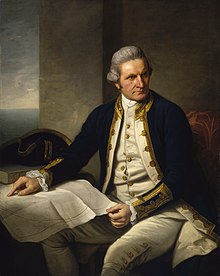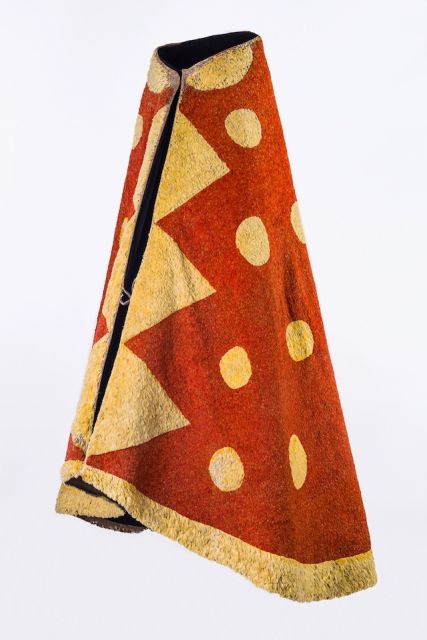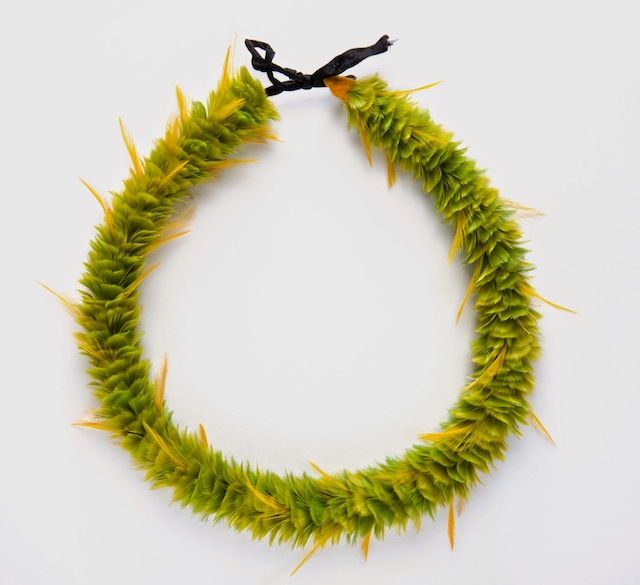
- The History of Kalaniopuu's Ahuula and MahioleCompiled by Amelia Gora (2015)The following is the background of Kalaniopuu's worldly treasures:
Ali'i Nui of Kaʻū
Aliʻi Aimoku of HawaiʻiBorn c. 1729 Died April 1782
Kāʻilikiʻi, WaioʻahukiniKaʻūSpouse Kalola Pupuka-o-Honokawailani
Kalaiwahineuli
Kamakolunuiokalani
Mulehu
Kānekapōlei
Kekupuohi[1]Issue Kīwalaʻō
Kalaipaihala
Pualinui
Keōua Kuahuʻula
Keōua PeʻealeHouse House of Keawe Father Kalaninuiamamao Mother Kamakaimoku 1779 - Captain James Cook got the cape and helmet/ahuula and mahiole from Kalaniopuu, Alii Nui of the Big Island.
Born 7 November [O.S. 27 October] 1728
Marton (in present-dayMiddlesbrough) Yorkshire, EnglandDied 14 February 1779 (aged 50)
Kealakekua Bay, Kingdom of HawaiiNationality British Education Postgate School, Great Ayton Occupation Explorer, navigator, cartographer Title Captain Spouse(s) Elizabeth Batts Children James Cook, Nathaniel Cook, Elizabeth Cook, Joseph Cook, George Cook, Hugh Cook Parent(s) James Cook, Grace Pace Signature 1779 -"After the ships of Captain Cook left Hawaii Island shortly after the death of that British Captain, the ships went and landed at Kamchatka, on the eastern shores of Siberia.And there, the boxes in which these chiefly treasures of Hawaii were placed were let down and totally forgotten. And as a result of a lucky accident, these boxes were carried without the knowledge of what the contents were to the royal city of Saint Petersburg, Russia and left in a dark and damp [kawakawau] room in a warehouse in the city.Since then, as a result of a lucky accident [another!], the boxes were found and these precious treasures were discovered; and it was cared for in a Museum there. A high-ranking teacher from Saint Petersburg named Prof. Sirathonesky [Sviatlovsky] was the one who revealed this history while he was here in Hawaii. This Russian haole said that the ahuula are still whole. These Hawaiian royal gifts were sold by the British ship officers who sailed from Hawaii after the death of Captain Cook, and were kept in the hands of the government of Russia; and as a result of the sale by those British men to the officials of Russia at Eastern Siberia, they received food and other goods from the Russians.It is said that The Russian government agreed to swap one of these ahuula and ahu mamo with the museum of Mrs. Pauahi Bishop for some ancient treasures within that museum."Note: From the Russians, the Russian government, there is a break as to who sold the ahuula and mahiole. But the English had it thereafter.1806 - Leverian Museum, England, had the Ahuula and Mahiole and sold it to William Bullock of another London Museum. Some of the items were given by Sir Joseph Banks.1819 - William Bullock sold to Private Collector Charles Winn.1912 - 93 years later, Charles Winn's grandson Second Baron St. Oswald gifted the Ahuula and Mahiole to "the Dominion of New Zealand" whose Museum Director was Augustus Hamilton.2015 - Aetearoa/New Zealand Museum has intentions of transferring both ahuula and mahiole in care of the Bishop Museum.OHA/Office of Hawaiian Affairs intends to be the receiver of the gifts while looking for the descendants/heirs of Kalaniopuu.Kalaniopuu's descendants/heirs exists, some descending from one or two of his children; however, our families are the descendants/heirs of four (4) of his six (6) children.OHA/Office of Hawaiian Affairs, the entity State of Hawaii, an occupier are Not related to us.Kalaniopuu's descendants/heirs, please contact us at theiolani@gmail.comaloha.References
- Jump up^ http://nupepa-hawaii.com/2015/07/24/miriam-kekupuohi-dies-1836/
- Jump up^ William De Witt Alexander (1891). A brief history of the Hawaiian people. American Book Co. pp. 104–116.
- Jump up^ "'ahu 'ula (Feathered cloak)". Museum of New Zealand web site. Retrieved 2009-07-19.
- Jump up^ "Mahiole (helmet)". Museum of New Zealand web site. Retrieved 2009-07-19.
Preceded by
Alii Kaiʻinamao Kalani-nui-i-a-mamao, 1st Aliʻi of KauAliʻi of Kaʻū
?–1782Succeeded by
KīwalaʻōPreceded by
AlapaʻinuiakauauaRuler of Hawaiʻi Island
1754–1782Succeeded by
KīwalaʻōCategories:- Royalty of Hawaii (island)
- Hawaiian military personnel
- 1782 deaths
- House of Keawe
- Burials at the Royal Mausoleum of Hawaii
wikipedia.comLuxurious Hawaiian Featherwork Makes its Mainland Debut
 'Ahu 'ula (cape), pre-1861. (Courtesy: Bernice Pauahi Bishop Museum, Ethnology Collection)
'Ahu 'ula (cape), pre-1861. (Courtesy: Bernice Pauahi Bishop Museum, Ethnology Collection)
Royal Hawaiian Featherwork: Nā Hulu Ali’i, on view at the de Young museum and on loan from the Bernice Pauahi Bishop Museum in Honolulu, is a gorgeous collection of 18th to early 20th century objects made for Hawaiian rulers. The approximately 75 pieces, including ‘ahu ‘ula (long cloaks and short capes), kāhili(royal staffs of feathers), lei hulu manu (feathered lei) and mahiole (helmets) once provided spiritual protection and indications of status. Today they give glimpses into the lives of royals during a turbulent era. The objects tell a story of a people impacted by everything from European explorers and Christian missionaries to annexation by the United States (and ensuing protests by Hawaiians).
‘Ahu ‘ula (cloak), possibly mid-18th century. (Courtesy: Bernice Pauahi Bishop Museum, Ethnology Collection)Princess Ka’iulani of Waikiki wore a lei made of yellow‘ō’ō feathers, red and green Kuhl’s lorikeet feathers and black ribbon on her 1893 journey to Washington, D.C., which she took to protest the overthrow of the Hawaiian monarchy. As a girl, Queen Emma wore a cape decorated with crescent shapes at the Chief’s Children’s School in Honolulu, run by two of the first missionaries to arrive on the islands. A large, bold cloak of ‘i’iwi feathers, ‘ō’ō feathers and olonā fiber was given to US Naval Officer Lawrence Kearny as a gift for protesting British Admiral Lord George Paulet’s claim of British sovereignty over Hawaii.The ‘ahu ‘ula’s clean lines, thick stripes, and in one case, full circles, appear remarkably modern. Had I seen them out of context, I might think they were made two centuries later. Like avant-garde artist Sonia Delaunay‘s brilliant textiles, the capes feel like bright, rich fields one might melt into. These objects are, in certain senses of the word, delicious.Feathers in mass quantity recall and simulate a range of substances, textures and environments. A large cloak made of brown pheasant feathers shimmers like a lake; an earthy red cloak appears softer, like powder; and one could mistake the white section of a hexagonal 18th-century cape for cotton.Many of the lei, looped and tied with black silk ribbons, resemble large caterpillars. Laying flat below them, a 20th-century lei humupapa, made of blue Indian peafowl or green pheasant male feathers and dark blue woven wool fleece, appears reptilian. The flexible connotations of these solid, functional and spiritual garments make them transportive presences.
Lei hulu (feather lei), 19th century. (Courtesy: Bernice Pauahi Bishop Museum, Henriques Collection)After spending several minutes looking closely at thousands of tiny, overlapping feathers, sensing the layers upon layers of concentration that built them, it is amazing to learn (thanks to a display of birds loaned from the California Academy of Sciences) that often, a single bird contributed only a few feathers to a piece. The now-extinct ‘ō’ō bird sported just two yellow feathers; its many remaining brown and black feathers went uncollected. The largest cloaks, made with up to half a million feathers, required an estimated 80,000 birds, and were constructed over the course of a generation.Though one cannot see the ‘ahu ‘ula in action, 18th and 19th-century oil paintings and works on paper provide representations of how they fell over the bodies of royals. In Titan Ramsay Peale’s Kilauea by Day (1842), the bold capes and helmets of warriors stand out against a vast, smoking volcanic crater.Royal Hawaiian Featherwork is, in many ways, a show of extremes: countless tiny, delicate feathers secured by exceptionally strong fiber; very bright yellow, rich red, deep black and near-alien greens; attire constructed expressly to be draped over the shoulders of rulers or rest in the hair of the elite.It will be difficult to get these loud, luxurious works out my head, along with at least a few of the Hawaiian words I learned while walking through the gallery. I venture to say that anyone — art lover or hater, fashion enthusiast, Twitter exec, kid in a stroller — would find these garments irresistible, and might, as I did, daydream about wearing one out of the museum into the unstoppable greens of Golden Gate Park.Royal Hawaiian Featherwork: Nā Hulu Ali’i is on view at the de Young through Feb. 28, 2016. For tickets and more information, visit deyoung.famsf.org.
Miriam Kekupuohi dies, 1836.
[Found under: “MAKE.”]
Kailua, Hawaii, Feb. 9, 1836.Died here in Kailua was the chiefess named Miriama Kekupuohi, on the 8th of February. She belonged to the church for eight years, and she was one of the first converts of Kailua nei. She was not known to have any entanglements.She was very old, perhaps 80 years old. She was a wife of Kalaiopuu,* the chief when Lono [Captain Cook] came, in the first ship to arrive in Kaawaloa.O Brethren, very true are the words of James 4:14. “Whereas ye know not what shall be on the morrow. For what is your life? It is even a vapour, that appeareth for a little time, and then vanisheth away.” By DANIELA.*Kalaiopuu was also known as Kaleiopuu and today is more commonly known as Kalaniopuu.(Kumu Hawaii, 3/16/1836, p. 24)Replies to This Discussion
- Amelia Gora http://tpo.tepapa.govt.nz/ViewTopicExhibitDetail.asp... It was gifted to the Aeteaoa Museum in 1912 by Lord St. Oswald who got it from his ancestor Charles Winn who got it from William Bullock who purchased it from collectors....









No comments:
Post a Comment